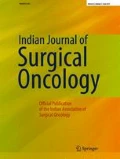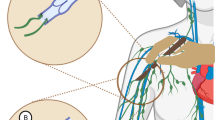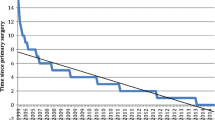Abstract
Newer advances in breast cancer management have led to increased disease free survival and overall survival. It is important to prevent debilitating complications after axillary lymph node dissection (ALND) to be able to successfully translate this survival benefit to quality of life benefit. By reducing disruption of lymphatic channels, sentinel lymph node biopsy (SLNB) decreases incidence of lymphedema (LE). Initiating early physiotherapy regimens, too, improves arm symptoms. In this review, we analyze the incidence of LE at our center and compare it with western literature. Retrospective analysis of all post-surgery breast cancer 18 patients, who followed up routinely with our oncophysiotherapist, was carried out. Incidence of LE in patients undergoing SLNB or ALND was followed up for a mean period of 17.5 months. Only 3.6%, i.e., 6 patients out of 166 developed LE. Amongst 166, 80 had only SLNB; the rest had ALND (either upfront or post-positive SLNB). None of the SLNB only cohort patients developed LE. SLNB in clinically node negative axilla, followed by initiation of arm physiotherapy early in post-operative period, may reduce LE incidence in breast cancer patients.
Similar content being viewed by others
Abbreviations
- LE:
-
Lymphedema
- ALND:
-
Axillary lymph node dissection
- SLNB:
-
Sentinel lymph node biopsy
- SLNB F/B ALND:
-
Sentinel lymph node biopsy followed by axillary lymph node dissection
- QoL:
-
Quality of life
References
Gupta A, Shridhar K, Dhillon PK (2015) A review of breast cancer awareness among women in India: cancer literate or awareness deficit? Eur J Cancer 51:2058–2066
Programme NCR (2001) Consolidated report of the population based cancer registries 1990–1996. Indian Council of Medical Research, New Delhi
Saxena S, Rekhi B, Bansal A, Bagga A, Chintamani MNS (2005) Clinico-morphological patterns of breast cancer including family history in a New Delhi hospital, India – a cross-sectional study. World J Surg Oncol 3:67. https://doi.org/10.1186/1477-7819-3-67
Brar P, Jain S, Singh I (2011) Complications of axillary lymph node dissection in treatment of early breast cancer: a comparison of MRM and BCS. Indian J Surg Oncol 2(2):126–132. https://doi.org/10.1007/s13193-011-0078-2
DiSipio T, Rye S, Newman B, Hayes S (2013) Incidence of unilateral arm lymphoedema after breast cancer: a systematic review and meta-analysis. Lancet Oncol 14(6):500–515. https://doi.org/10.1016/s1470-2045(13)70076-7
Golshan M, Martin WJ, Dowlatshahi K (2003) Sentinel lymph node biopsy lowers the rate of lymphedema when compared with standard axillary lymph node dissection. Am Surg 69(3):209–211
Mansel RE, Fallowfield L, Kissin M, Goyal A, Newcombe RG, Dixon JM, Yiangou C, Horgan K, Bundred N, Monypenny I, England D, Sibbering M, Abdullah TI, Barr L, Chetty U, Sinnett DH, Fleissig A, Clarke D, Ell PJ (2006) Randomized multicenter trial of sentinel node biopsy versus standard axillary treatment in operable breast cancer: the ALMANAC trial. J Natl Cancer Inst 98(9):599–609. https://doi.org/10.1093/jnci/djj158
Lucci A, McCall LM, Beitsch PD et al (2007) Surgical complications associated with sentinel lymph node dissection (SLND) plus axillary lymph node dissection compared with SLND alone in the American College of Surgeons Oncology Group Trial Z0011. J Clin Oncol 25(24):3657–3663
McLaughlin SA, Wright MJ, Morris KT (2008) Prevalence of lymphedema in women with breast cancer 5 years after sentinel lymph node biopsy or axillary dissection: objective measurements. J Clin Oncol 26(32):5213–5219. https://doi.org/10.1200/jco.2008.16.3725
Crane-Okada R, Wascher RA, Elashoff D, Giuliano AE (2008) Long-term morbidity of sentinel node biopsy versus complete axillary dissection for unilateral breast cancer. Ann Surg Oncol 15(7):1996–2005. https://doi.org/10.1245/s10434-008-9909-y
Çinar N, Seçin U, Keskin D, Bodur H, Bozkurt B, Cengiz O (2008) The effectiveness of early rehabilitation in patients with modified radical mastectomy. Cancer Nurs 31:160–165
Todd J, Scally A, Dodwell D, Horgaan K, Topping A (2008) A randomized controlled trial of two programmes of shoulder exercise following axillary lymph node dissection for invasive breast cancer. Physiotherapy 94:265–273
Torres Lacomba M, Yuste Sánchez MJ, Zapico Goñi Á (2010) Effectiveness of early physiotherapy to prevent lymphoedema after surgery for breast cancer: randomised, single blinded, clinical trial. BMJ 340:b5396
Box RC, Reul-Hirche HM, Bullock-Saxton JE, Furnival CM (2002) Physiotherapy after breast cancer surgery: results of a randomized controlled study to minimise lymphedema. Breast Cancer Res Treat 75(1):51–64
Hsiao PC, Hong R, Chou W, Lu SR (2015) Role of physiotherapy and patient education in lymphedema control following breast cancer surgery. Ther Clin Risk Manag:319. https://doi.org/10.2147/tcrm.s77669
Scaffidi M, Vulpiani MC, Vetrano M, Conforti F, Marchetti MR, Bonifacino A, Marchetti P, Saraceni VM, Ferretti A (2012) Early rehabilitation reduces the onset of complications in the upper limb following breast cancer surgery. Eur J Phys Rehabil Med 48:601–611
Acknowledgments
We would like to acknowledge the data extraction efforts of our research analyst, Ms. Shakti Srivastav.
Author information
Authors and Affiliations
Corresponding author
Ethics declarations
Informed Consent
Informed consent was taken from all participants before enrolling them in the study.
Additional information
Publisher’s Note
Springer Nature remains neutral with regard to jurisdictional claims in published maps and institutional affiliations.
Rights and permissions
About this article
Cite this article
Gupta, S., Gupta, N., Kadayaprath, G. et al. Use of Sentinel Lymph Node Biopsy and Early Physiotherapy to Reduce Incidence of Lymphedema After Breast Cancer Surgery: an Institutional Experience. Indian J Surg Oncol 11, 15–18 (2020). https://doi.org/10.1007/s13193-019-01030-4
Received:
Accepted:
Published:
Issue Date:
DOI: https://doi.org/10.1007/s13193-019-01030-4




